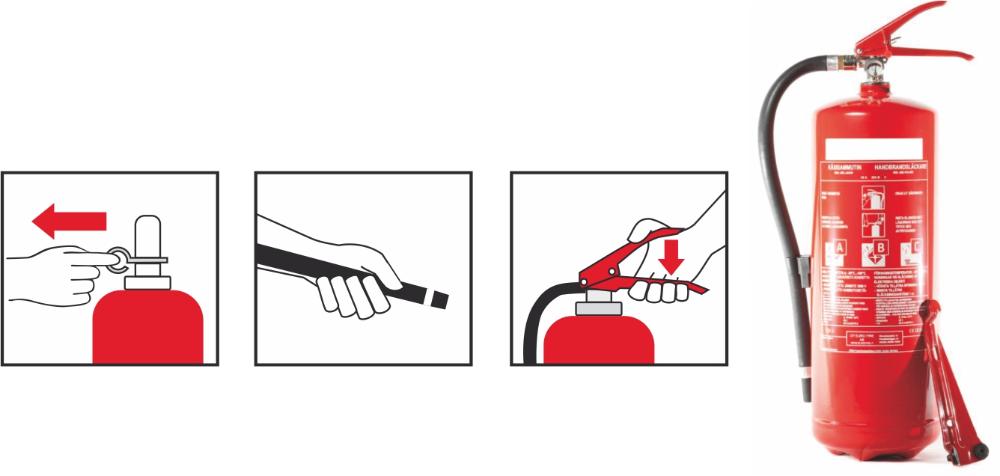

Using a portable extinguisher
Practise using a portable fire extinguisher
Take interest in your firefighting equipment and practise whenever you can. Check in advance the types of fires your extinguisher is suitable for and at least read the instructions on the extinguisher.
How to operate
- Take the extinguisher down from the wall mount/bracket and go closer to the fire.
- Put the bottle on the ground, detach the hose from its holder.
- Pull out the safety pin in the upper handle with a sharp tug.
- Lift the extinguisher up by the lower handle and grasp the hose nozzle.
- Aim at the burning object, direct the nozzle at the base of the fire.
- Press the top handle of the extinguisher down fully.
- Go closer to the burning object and spray the extinguishing agent on it with a sweeping side to side movement of the nozzle.
- When the flames have been put out, release the top handle. Observe the site of the fire. If the fire breaks out again, extinguish it. Turning the extinguisher on and off saves the extinguishing agent and allows you to put out even large fires.

Operating distance depends on the extinguisher type
- When using powder extinguishers, stay within 1.5 to 3 metres from the site of the fire.
- Foam and liquid extinguishers can be used efficiently within a distance of 0.5 to 1.5 metres from the fire.
- With a carbon dioxide extinguisher, a fire can be extinguished effectively from a distance of 0.5 to 1.5 m. Take into account the cooling and smothering effect of carbon dioxide (as it displaces oxygen).
- With water extinguishers, you should stay within 3 metres or more from the fire, depending on its type.
Powder extinguishers
Powder extinguishers have ABC classification and are suitable for putting out almost all types of fires, such as solid, liquid and gaseous substances. They are also suitable for putting out electrical fires. The powder chemically interrupts the chain reaction of combustion and also has a smothering effect.
In addition to powder extinguishers with ABC classification, there are ones with BC classification, which are used in special situations in manufacturing, and D class powder extinguishers used to put out metal fires. Powder extinguishers can withstand cold (sub-zero temperatures), vibration and moisture. After using a powder extinguisher, the cleaning operation is demanding, as its fine dust spreads everywhere. It also corrodes and oxidises electronic devices.
Liquid and foam extinguishers
As the name indicates, the extinguishing agent used in liquid fire extinguishers is either a liquid or a liquid-based foam. They are suitable for putting out liquid and solid substances. Liquid extinguishers are used to put out class AB fires.
Most liquid extinguishers are also suitable for electrical fires. Check the safety distances given on the instruction label. A class F (film-forming) foam extinguisher is suitable for grease fires. It is a good fire extinguisher for kitchens with deep fat fryer tanks.
These extinguishers should usually be stored in a warm place. When used in cold conditions, it is always advisable to check the extinguisher’s minimum operating temperature.
The advantage of liquid extinguishers is that they make for easier after-cleaning than powder extinguishers. This is why liquid extinguishers are well suited for homes, offices, hospitals and animal shelters.
Carbon dioxide extinguishers
A carbon dioxide extinguisher is ideal for putting out electrical and liquid fires. Carbon dioxide is a pure gas which does not soil things around it. This makes it particularly suitable for also putting out fires in electrical appliances. Carbon dioxide does not conduct electricity.
The effect of the extinguishing agent is based on oxygen displacement and cooling. Carbon dioxide comes out at the approximately temperature of -75 ° C and should not be sprayed on people.
When used in small spaces, you should notice the strong oxygen displacement effect of carbon dioxide. Leave the room immediately after using a carbon dioxide extinguisher.
Carbon dioxide extinguishers work best indoors, as outdoors such factors as the wind undermine their effect.
Read more:
First aid firefighting
Fire blanket


